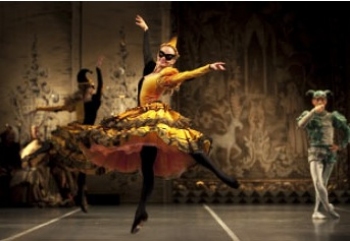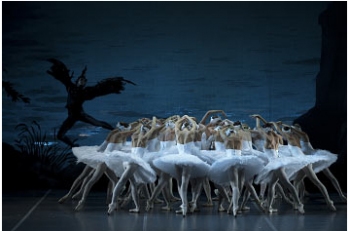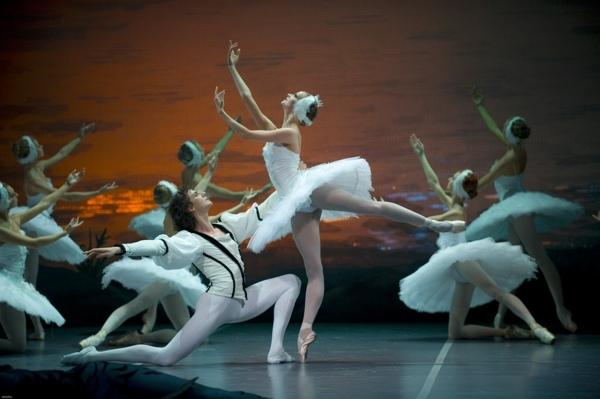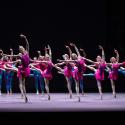It would be tough for any Russian ballet company to come into worldly, balletwise London just ahead of the great Bolshoi, but the Mikhailovsky Ballet make a very pleasing impression in their first week at the Coliseum with a pretty and historically interesting Swan Lake and a gently antique Giselle, and dancing that more than most underscores the rare pleasures of period style.
The Swan Lake production is significant for both London and the Bolshoi, in fact, as it is a careful restaging of that 1956 version in which the Bolshoi made an indelible smash hit of their first trip here. Overtaken 40 years ago by Yuri Grigorovich’s own complete remake that remains entrenched in Moscow, this earlier production has been picked up and revived by the second-ranking ballet company of St Petersburg, where the dancers have a softer and more reticent style that makes this a dainty dish.
 The designs are recreations of early ones by the great Bolshoi designer Simon Virsaladze, who later adopted a brasher, more expressionist manner in his designs for Grigorovich; but what a chic couturier he could be, spiralling deft black curlicues up white silk, trimming narrow waists with golden girdles, and popping a little feathered hat, cape and heeled white shoes on the hero. Tints of duck-egg, rust and soft gold warm the graphic black and white. I'm sorry at the substitution of the sexy, perky little tutus of the 1956 production by longer, softer swan tutus, but otherwise this is a relishable parade of Fifties ballet fashions.
The designs are recreations of early ones by the great Bolshoi designer Simon Virsaladze, who later adopted a brasher, more expressionist manner in his designs for Grigorovich; but what a chic couturier he could be, spiralling deft black curlicues up white silk, trimming narrow waists with golden girdles, and popping a little feathered hat, cape and heeled white shoes on the hero. Tints of duck-egg, rust and soft gold warm the graphic black and white. I'm sorry at the substitution of the sexy, perky little tutus of the 1956 production by longer, softer swan tutus, but otherwise this is a relishable parade of Fifties ballet fashions.
Choreographically, it is a freehand fusion of the 1892 Petipa/Ivanov with 60 years of embellishments and alterations by Alexander Gorsky and Asaf Messerer, each trying in their way to satisfy current fashions in theatre art. These entail removing the mime and more static parts and packing the work with optimistic jesters and nose-to-tail dances that leave no time to reflect too much on the possibly greater ripples in human nature that could be found in it.
If you appreciate Swan Lake as a romance of emotional and spiritual schism, this is not the production for you, but it has some very lovely free-running swan ensembles, less symmetrical than Ivanov’s, but more expressive of nature. These swans commune actively in the encounter between Odette, their queen, and the Prince. I don’t think the Mikhailovsky's obedient girls yet have found possession of the music or quite its poetic song, in the way that creates a holy corps de ballet, but they have those fluid St Petersburg backs and necks that wash grace through any movement.
 And there are choice period acting details that seem terribly-terribly Fifties, such as the nice Soviet briskness of the mime between Prince Siegfried and the Queen in Act One. In many productions her draconian order to him to get married or else is the critical plot hinge that sets off his flight to the lake and the subsequent magical fantasy. Here it went: Queen, gesturing: “Two girls here. You going to marry one of them?” Prince: “No, mother.” Queen: “Ah. Goodbye.”
And there are choice period acting details that seem terribly-terribly Fifties, such as the nice Soviet briskness of the mime between Prince Siegfried and the Queen in Act One. In many productions her draconian order to him to get married or else is the critical plot hinge that sets off his flight to the lake and the subsequent magical fantasy. Here it went: Queen, gesturing: “Two girls here. You going to marry one of them?” Prince: “No, mother.” Queen: “Ah. Goodbye.”
The performances reflected this reticence, with dainty court damsels and Denis Tolmachev’s tough and tiny jester bringing a bit of welcome macho to the stage rather overpopulated with mousey men. Alas, the leading man, Marat Shemiunov, danced in such ladylike fashion that I would have preferred a girl in breeches, frankly. Very tall, but very Julian Clary and not technically competent. I couldn’t blame the Odette/ Odile, Ekaterina Borchenko, for showing not the faintest awareness that there was a man about the place at all, as she dutifully exaggerated and stretched out every swan pose 2010-style with little regard for music. But I suspect she was shaking with nerves, frequently dropping her chin and seeming to lose the thread of her steps here and there.
The pity was that the music was being so well played by the Mikhailovsky orchestra and their excellent conductor Pavel Bubelnikov. Here, as in Giselle last night, one sensed that fine musical values were being wasted on dancers anxious to deliver steps correctly on predictable counts in the studio, rather than float them on music in the theatre. But I suspect this very pretty Swan Lake will warm up during its several performances - and I’d love to see what the Royal Ballet’s Tamara Rojo makes of it when she guests next week. She will look sensational in the black and red Odile tutu.
If the Swan Lake's period feeling is 20th-century, the period attraction of the Mikhailovsky’s Giselle is quite another story - it’s a rather beguiling "old" production, without one blatantly lifted leg, and performed with a chamber softness and sweetness that puts it beautifully in its 1840s historical context. This staging by Nikita Dolgushin (a major figure in the Mikhailovsky company’s eclectic past) is almost the balletic equivalent of a Donizetti opera, styled in keeping with its original period, with only a few concessions to modern Russia in the form of reduced mime and a court dressed like the diamond suit in a pack of cards (unfortunately nowhere near as delectably as Virsaladze's Swan Lake courtiers).
 The girls of the corps de ballet again impressed with their gentleness and obedience - the Wilis here appear like girls lost at a garden party, waltzing in virginal ball dresses with flowered circlets in their hair. Though their veils fly magically off their heads as if plucked by spirits, there is nothing sinister about them, and the woods are more of a park than a forest, so the impression is lightly traced with lyrical regret rather than vengeance. There was a strong and elegant Queen of the Wilis, the black-haired Irina Kosheleva, offering a more emphatic, later period in her style of dancing and jumping, which suited the character.
The girls of the corps de ballet again impressed with their gentleness and obedience - the Wilis here appear like girls lost at a garden party, waltzing in virginal ball dresses with flowered circlets in their hair. Though their veils fly magically off their heads as if plucked by spirits, there is nothing sinister about them, and the woods are more of a park than a forest, so the impression is lightly traced with lyrical regret rather than vengeance. There was a strong and elegant Queen of the Wilis, the black-haired Irina Kosheleva, offering a more emphatic, later period in her style of dancing and jumping, which suited the character.
But I’m really just circling the scene with flowers in preparation, because at the heart of last night’s Giselle was an outstandingly eloquent performance by Irina Perren (pictured left). Quite tall, with slender limbs and a high floating jump, she was a charmer from her first entrance, skipping unselfconsciously and holding her blushing cheek as she heard Albrecht’s blown kisses, as responsive and blameless as a child. Denis Matvienko, a fine dancer who majors in suavity and sported an eyecatching blond blow-dry, was a terrific foil for her dramatically, so obviously a deceiver.
 As Act Two unwound, Matvienko's Albrecht temporarily became more serious - one sensed it was only temporary - while Perren became the acme of love and hope, her whole body silken with yearning (a good viola soloist here too). Some details look slightly dubious: though we had Giselle flying through the air satisfactorily, we also had her mother going even madder than the daughter did (rending her hair and beating her breast à la Lady Capulet), and a hunting party of aristocrats who clearly can’t step out of their spindly castle without loading on all their gold and all their jewels, as well as every hat, feather and beribboned javelin they possess (pictured right).
As Act Two unwound, Matvienko's Albrecht temporarily became more serious - one sensed it was only temporary - while Perren became the acme of love and hope, her whole body silken with yearning (a good viola soloist here too). Some details look slightly dubious: though we had Giselle flying through the air satisfactorily, we also had her mother going even madder than the daughter did (rending her hair and beating her breast à la Lady Capulet), and a hunting party of aristocrats who clearly can’t step out of their spindly castle without loading on all their gold and all their jewels, as well as every hat, feather and beribboned javelin they possess (pictured right).
A riddle: how come Giselle, 50 years older than Swan Lake and with inferior music, retains so much of its original choreographic text that you can hardly thread a pink ribbon between productions - while Swan Lake, so much younger and with such magnificent passages of choreography and music, is doomed to stagger from fashion change to fashion change? The Mikhailovsky Ballet under their chief balletmaster Mikhail Messerer add to the richness of appreciation of this weird and much put-upon theatrical artform with their stagings.
- The Mikhailovsky Ballet perform at the London Coliseum in Swan Lake (tomorrow, 22-25 July), Giselle (tonight), Cipollino, a children's ballet (17 & 24), a mixed programme (Sunday) and Chabukiani's Laurencia (20 & 21 July)
- theartsdesk interview with Mikhail Messerer about reconstructing the 1956 Swan Lake














Add comment